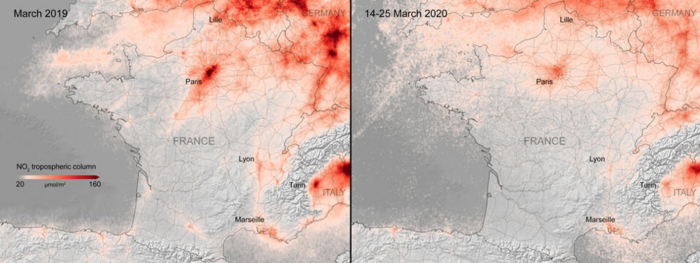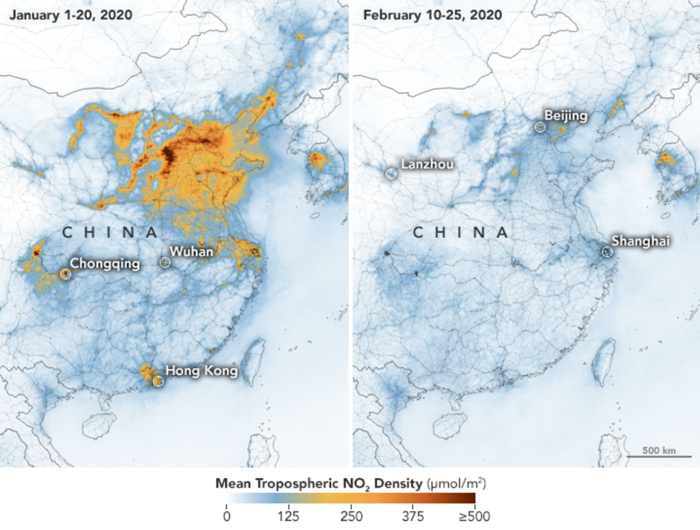


The coronavirus outbreak is associated with strong decreases in air pollution in cities worldwide. This can be seen in Figures 1 and 2 (below), which contain satellite images indicating large drops in nitrogen dioxide (NO2, a major air pollutant) concentrations in different cities across China and France, coinciding with quarantine measures.
Ambient air pollution is a major contributor to global health problems, estimated to cause 4.2 million premature deaths worldwide per year (WHO, 2018). This mortality is due to exposure to small particulate matter of 2.5 microns or less in diameter (PM2.5), which cause cardiovascular and respiratory disease (ibid.). While these conditions sound familiar from recent reporting, they are indeed the same pre-existing factors that also increase the risk of dying from COVID-19 (Wu et al., 2020).
Wu et al. (2020), medical researchers from Harvard University, have now shown that COVID-19 mortality is exacerbated by long-term exposure to air pollution. Using data from about 3000 U.S. counties, the authors find that an increase in long-term exposure to air pollution by 1μg/m3 in PM2.5 increases COVID-19 mortality by as much as 15%.
Though the links between pandemic-related mortality and air pollution tend not to take center-stage in debates of pandemic outbreaks, earlier research had already identified those interdependencies. Drawing on a newly constructed panel of infant and all-age mortality for the period 1915 to 1925 in 1180 American cities, Clay et al. (2018) show that more polluted cities experienced large relative increases in infant and all-age mortality associated with the 1918 influenza pandemic (the ‘Spanish Flu’). Clay et al. (2018) rely on the sharp onset of the pandemic, combined with variation in cities’ exposure to air pollution from nearby coal-fired power plants to implement a difference-in-differences approach. Classifying cities into high, medium and low exposure, the identifying assumption of the paper is that the increase in mortality from the 1918 pandemic across the three city types would have been similar in the absence of differences in exposure in pollution due to the coal plants. This assumption should hold after controlling for factors that might lead to other differential changes in mortality related to baseline city characteristics and pre-pandemic mortality rates.
Clay et al. (2018) find that infant (all-age) mortality increased by 11% (10%) in high coal-capacity cities, and by 8% (5%) in medium coal-capacity cities relative to the baseline (low coal-capacity). This implies that pollution in high and medium coal-capacity cities caused 30-42,000 additional deaths, or 19-26% of total pandemic mortality. The inclusion of a rich set of controls, including city poverty, baseline health conditions and water quality, the timing of pandemic onset and local containment measures, as well as alternative regression specifications and a range of robustness checks, leave those results unchanged.
In light of these findings, recent moves to roll back fuel economy standards for new cars in the U.S. as well as demands by European carmakers to delay the application of new emissions standards to help buffer the production fallout due to COVID-19 seem counterproductive: The detrimental effects of air pollution are large already and contribute to exacerbating public health crises. Any rollback of pollution standards can take additional lives – also in the absence of a global pandemic.
[insert image 1]
Copyright Arlinghaus-Vogt
Figure 1: Air pollution in Paris, March 2019 (left) and March 2020 (right), Source: European Space Agency (2020)
[insert image 2]
Copyright Arlinghaus-Vogt
Figure 2: Air pollution in Chinese cities in January 2020 (left) and February 2020 (right), Source: NASA (2020)
[1] We thank Johannes Seebauer (DIW Berlin) for helpful comments and suggestions.
Johanna Arlinghaus (TU Berlin and MCC Berlin)
Angelika Vogt (HU Berlin)
European Space Agency. 2020. Coronavirus lockdown leading to drop in pollution across Europe. Published March 27, 2020. Accessed April 10, 2020.
Clay et al. 2018. Pollution, Infectious Disease, and Mortality: Evidence from the 1918 Spanish Influenza Pandemic. Karen Clay, Joshua Lewis, and Edson Severnini. The Journal of Economic History, vol 78(04), pages 1179-1209.
NASA. 2020. Airborne Nitrogen Dioxide Plummets Over China. Accessed April 10, 2020.
WHO. 2018. Ambient (outdoor) air pollution. Published May 2, 2018. Accessed April 15, 2020.
Wu et al. 2020. Exposure to air pollution and COVID-19 mortality in the United States. Xiao Wu, Rachel C. Nethery, Benjamin M. Sabath, Danielle Braun, Francesca Dominici. medRxiv 2020.04.05.20054502; doi: https://doi.org/10.1101/2020.04.05.20054502